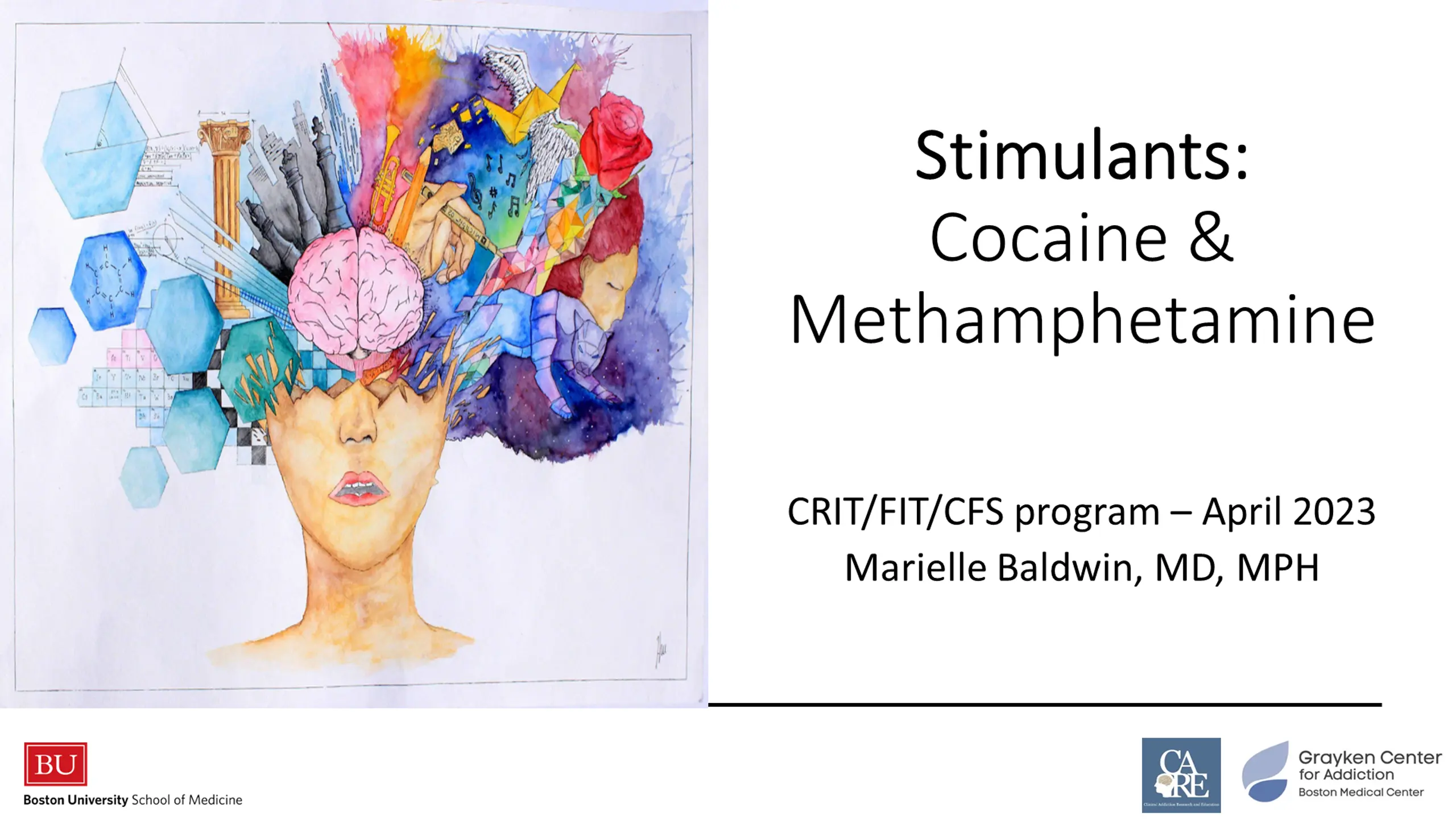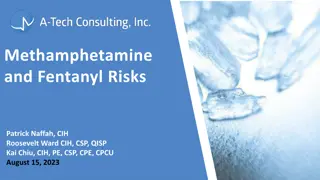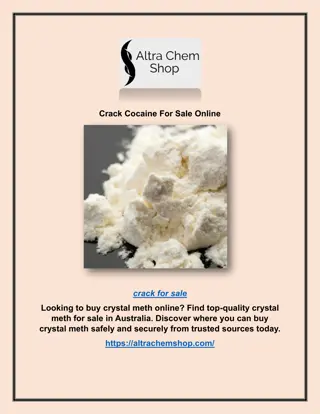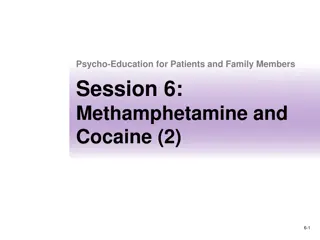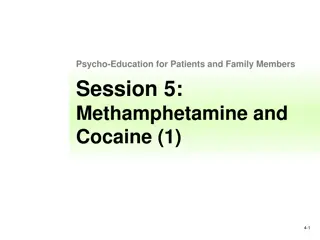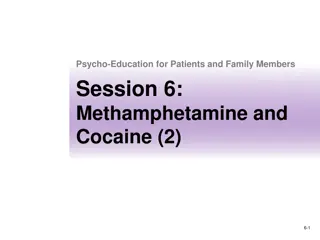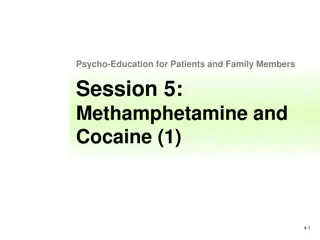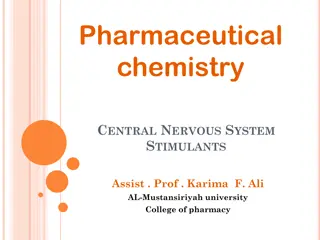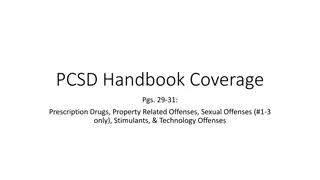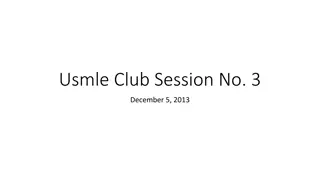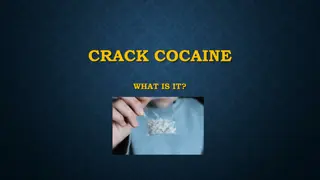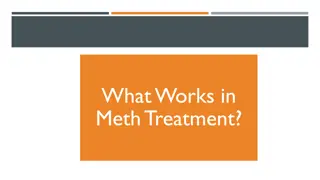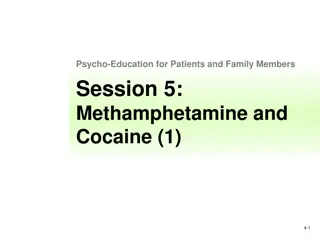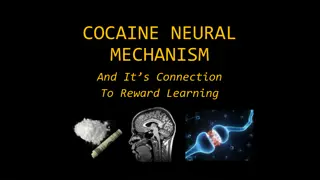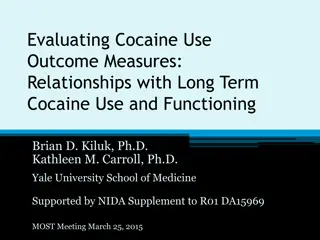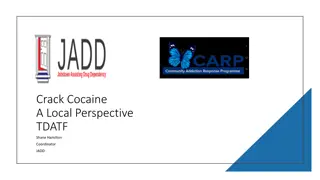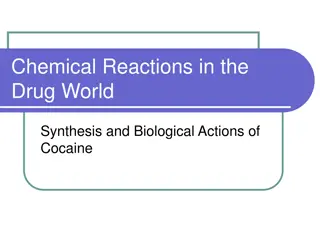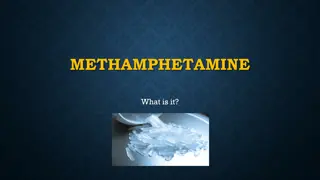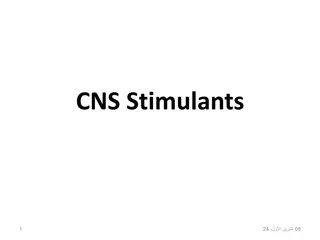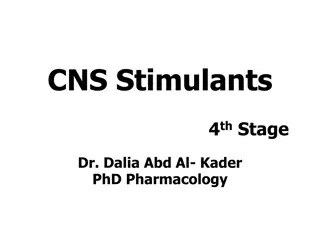Stimulants: Cocaine & Methamphetamine
Basics of cocaine and methamphetamine, including their history, medical complications, treatment options, and techniques to manage overamping.
Download Presentation

Please find below an Image/Link to download the presentation.
The content on the website is provided AS IS for your information and personal use only. It may not be sold, licensed, or shared on other websites without obtaining consent from the author.If you encounter any issues during the download, it is possible that the publisher has removed the file from their server.
You are allowed to download the files provided on this website for personal or commercial use, subject to the condition that they are used lawfully. All files are the property of their respective owners.
The content on the website is provided AS IS for your information and personal use only. It may not be sold, licensed, or shared on other websites without obtaining consent from the author.
E N D
Presentation Transcript
Stimulants: Stimulants: Cocaine & Methamphetamine CRIT/FIT/CFS program April 2023 Marielle Baldwin, MD, MPH
Disclosures I have no financial or other perceived conflicts of interest to disclose in relation to this presentation
Learning Objectives At the end of this session, participants will be able to: 1. Understand how and why people use stimulants 2. Name the medical complications of stimulant use 3. Describe the current options for treatment of stimulant use disorders 4. Identify the characteristics of stimulant intoxication and techniques to manage overamping
Basics of Cocaine & Methamphetamine Basics of Cocaine & Methamphetamine
Overview: Cocaine Derivative: erythroxylum coca leaves in Andes History of Use: Used in medicines and beverages until early 1900s Street preparations 10-50% cocaine Hydrochloride powder is sniffed or injected; Blow, Snow, Powder Alkaline rocks (aka crack) are smoked; Crack, Rock, Base Routes of Use: Intranasal, Intravenous, smoked/inhalation Metabolized: Rapidly absorbed, metabolized (liver), and excreted in the urine. Benzoylecgonine = metabolite *Prevents the reuptake of dopamine* Half-Life: IV 20-60 min, IN 60-90 min, smoked 5-15 min IN slower onset and prolonged action v. IV or smoked. Acute Medical Risks: myocardial infarction, arrhythmia, heart failure, hyperthermia, rhabdomyolysis, acute kidney injury, psychosis, death
Overview: (Meth)amphetamine Derivative: lab derived from ephedrine components Tina, Speed, Crystal, Crank, Ice, Meth History of Use: 1893 methamphetamine first synthesized in Japan as decongestant Route of Use: Inhalational, Intranasal, Intrarectal, Intravenous Metabolized: Renal and hepatic clearance, highly bioavailable, slowly metabolized *Increases dopamine in synaptic terminal AND prevents its reabsorption* Half-Life: Peaks ~2-4 hours after use Long life, between 10-12 hours, independent of route of use Acute Medical Risks: myocardial infarction, arrhythmia, heart failure, hyperthermia, rhabdomyolysis, acute kidney injury, psychosis (neurotoxicity), death Lineberry 2006
Epidemiology Epidemiology
Stimulant-involved overdose deaths surging with opioids https://nida.nih.gov/research-topics/trends-statistics/overdose-death-rates
Distribution of Psychostimulant Use SAMHSA, 2020; NSDUH, 2015
Disparities in Methamphetamine-Involved Overdose Deaths Han et al, JAMA Psych, 2021
Legacy of Structural Racism 1972 Controlled Substances Act: did not distinguish powder from crack cocaine 1986 Anti Drug Abuse Act: mandatory min sentencing for trafficking (100:1 ratio - 5 yrs for 5g crack vs 500g of powder) Despite harsher penalties for crack versus powder cocaine, crack use declined less than powder cocaine and even less than drugs not included in sentencing policies. These findings suggest that mandatory minimum sentencing may not be an effective method of deterring cocaine use. Walker LS, Mezuk B. Mandatory minimum sentencing policies and cocaine use in the U.S., 1985-2013. BMC Int Health Hum Rights. 2018 Nov 29;18(1):43. 1988 Anti-Drug Abuse Act: 5 year min for simple possession of crack 2010 Fair Sentencing Act: reduced sentencing disparity to 18:1 ratio crack:powder cocaine 2018 First Step Act: applied the 2010 rules retroactively and allowed for resentencing SAMHSA, 2020; NSDUH, 2015
Stimulants: Why & How Stimulants: Why & How
Why do people use stimulants? Euphoria / rush Onset and intensity depends on delivery method Increased energy, attention/focus Increased vigilance (survival) Diminished social inhibition Sexual enhancement (libido) Decreased appetite To counteract the sedative effect of opioids
Neurochemical Impact Cocaine prevents the reuptake of dopamine from the synapse. Methamphetamine both increases dopamine in the synaptic terminal AND prevents its reabsorption. Excessive dopamine with stimulant use is responsible for many of the motor and mood symptoms Alternatively, a dopamine deficit with abstinence contributes to the typical acute and post-acute withdrawal symptoms (Myers & DeWall, 2017) (Paulus & Stewart, 2020)
PK: Cocaine PK: Cocaine IV Smoked 3-5sec Snorted 1-5min Time to effect 10-60sec Peak concent. 3-5min 1-3min 15-20min Half-life 20-60min 5-15min 60-90min Lange, R. A. and L. D. Hillis (2001). "Cardiovascular complications of cocaine use." N Engl J Med 345(5): 351-8. PK: Methamphetamine PK: Methamphetamine IV Smoked 15-30 sec Immediate Snorted 3-5 min Ingested 15-20 min Time to effect Peak concent. 2-4 h 2-4 h 2-4 h 2-4 h Half-life 10-12 h 10-12 h 10-12 h 10-12 h Lineberry 2006
Binge Patterns of Use Binge patterns may include using sporadically or may occur multiple days in a row and may be common with early use. During a binge, initial substance use increases the desire to use more. Decreased desire to use varies based on stimulant: Cocaine 46 hours Methamphetamines day 4-5 Binge use patterns may result in more severe side effects and adverse events at the end of a binge episode. (Ward, et al, 1997) (Ruczenski et al, 2007)
Psychostimulant Withdrawal 53-97% of people experience withdrawal with abstinence after prolonged use Dopamine stores may take 12-18 months to recover, if at all, after chronic methamphetamine use Withdrawal symptoms may last weeks to months: Acute (1-7 days): (severe) depression, anhedonia with suicidal ideation, anxiety, fatigue with hypersomnia or insomnia, intense cravings, poor concentration, irritability, physical discomfort (myalgias), psychomotor retardation or agitation Post-acute (early protracted, 2-4 wks): vivid/unpleasant dreams, intermittent cravings w/nighttime awakenings Late protracted (> 4 weeks): mild cognitive dysfunction, cognitive dullness , impairments in memory and executive functioning, moderate depression/anxiety intermittent cravings Li, M; Shoptaw, S; Addiction, 2022 (S3 Practice Guidelines, 2016)
Health Consequences of Chronic Stimulant Use Dental Darkened teeth Periodontal disease Neuro-psychiatric Stroke Seizure Depression Anxiety Mania Psychosis (paranoia, AH/VH/TH) Liver Drug-induced hepatitis Cirrhosis or liver failure Pulmonary Acute pulmonary edema Pulmonary HTN Inhalation injury Cardiovascular Hypertension Arrhythmias Cardiomyopathy Acute Coronary Syndrome Aneurysm/dissection Erectile dysfunction Renal/Metabolic Rhabdomyolysis AKI/CKD Hyperthermia Skin Infectious HIV/AIDS HCV/HBV STIs SSTIs Superficial/deep tissue wounds/infections Excoriations Chemical burns
Cocaethylene Toxicity Cocaethylene = psychoactive substance produced when cocaine is used in presence of alcohol Alcohol interferes with metabolism of cocaine Longer life, more potent, larger volume of distribution 60-90% of people who use cocaine also use alcohol Alcohol as a landing gear from cocaine Prolongs and/or potentiates effects of cocaine Estimated to be 10x more cardiotoxic than cocaine alone Increased likelihood of liver injury, neurologic effects (seizures), death
Pharmacologic Management No FDA approved medications for stimulant use disorders Preliminary research with promise for: IM naltrexone + bupropion (methUD) mirtazapine (methUD) mixed amphetamine salts (CUD + ADHD, meth withdrawal) topiramate (CUD) topiramate + amphetamine salts (CUD) modafinil (post-acute stimulant withdrawal) o o o o o o (S3 Practice Guidelines, 2016)
Promising medications for Cocaine Use Disorder Cocaine Use Disorder Comparison Population Outcomes Dropout 73 Dutch patients with cocaine UD with OUD on MOUD (methadone) At 12 weeks Fewer days of cocaine use More cocaine-neg tox tests No differences in craving, use of other substances, or criminality Nuijten M et al. Lancet. 2016; 387:2226-34. Dexamphetamine 60mg QD vs. placebo 11% dropout At 13 weeks Reduced ADHD symptoms: 60-75% vs 40% 3-wk abstinence: 30-17% vs. 7% Levin FR et al. JAMA Psychiatry. 2015 1;72:593-602. Mixed amphetamines (MAS-ER) 60-80mg QD vs. placebo 126 US patients with adult-ADHD and cocaine UD 26% dropout Dakwar E et al. Am J Psychiatry. 2019 176(11):923-930. 40 min infusion of ketamine at 0.5mg/kg vs. midazolam + All 5- wks counseling At 5 weeks Abstinence: 48% vs. 11% Cravings: Ketamine 58% lower dropout: 26% ketamine; 57% midazolam 55 inpatients with cocaine UD 127 adults with CUD using at least 9 days in the prior month 20% discontinued for elevated HR/BP MAS-ER at 60mg QD + topiramate 100 BID vs. plaebo Levin FR et al. DAD 2020 206:107700. At 3 weeks Abstinence: 14% vs. 0%
Promising medications for Methamphetamine Use Disorder MA Use Disorder Comparison Population Outcomes Limitations At 24 weeks RR of 0.75 for MA use RR <0.52 for multiple sex partners, condomless anal sex Improved depressive symptoms and insomnia severity 120 men who have sex with men who use methamphetamine Coffin PO et al. JAMA Psychiatry 2020 77(3):246-255 Mirtazapine 30mg vs. placebo once daily + counseling Medication adherence was almost 40% Adherence to medication was 75-86%, Adverse events: Nausea, vomiting, dizziness 403 with MA UD in stage 1 and 225 with MA UD in stage 2 Trivedi MH et al. N Engl J Med. 2021 384(2):140- 153 IM-NTX 380mg Q3wks +Bupropion 450mg vs. placebo At 12 weeks BPP+NTX 13.6% vs. Placebo 2.5% (3 of 4 MA negative urine tox)
Behavioral Interventions for StUD References Evidence-Based Treatments Description of Treatment (Bach et al., 2020; Brown & DeFulio, 2020; Lake et al., 2020; Minozzi et al., 2016; Okafor et al., 2020) Provides reinforcers ($, gift cards, motivational encouragement, etc) for treatment adherence. Contingency Management (Meyers et al., 2011; Riccardo De Giorgi et al., 2018; Stitzer et al., 2011) Using therapeutic modalities, job training, education, behavioral skills training, social training, relapse prevention and relationship counseling. Community Reinforcement Approach (Huber et al., 1997; Rawson et al., 1995, 2002) An 8-16-week structured intensive outpatient group utilizing group therapy, connection to self-help, and exploration of underlying causes of disease. Regular UDS screening. Matrix Model (Huang et al., 2020; Killeen et al., 2020; Liu et al., 2021; Zhou et al., 2021) Varying exercise programs have been described, but those with a combination of daily aerobic and anaerobic exercise are associated with long term recovery. Exercise Supported Recovery (Lange-Altman et al., 2017; Lenz et al., 2016; Morley et al., 2016; Murphy et al., 2019; Najavits & Anderson, n.d.; Sperlich et al., 2021; Takahashi et al., 2020) A therapeutic model for the treatment of co-occurring PTSD and SUD that emphasizes the need to be safe in order to explore and cope with trauma. Trauma-Informed Care Seeking Safety
CM + CRA Comparing Behavioral Health Approaches CM + 12 Step CRA + Incentives Research indicates that a combination of behavioral health approaches are most effective in producing abstinence at 12 weeks CM + CBT CM CRA 12 Step +Incentives Contingency management combined with any additional behavioral health approach improves outcomes 12 Step Meditation CBT Incentives DeCrescenzo, et al, 2018 Key: CRA=Community Reinforcement Approach, CM=Contingency Management, CBT=Cognitive Behavioral Therapy Psychodynamic therapy
Basics of Contingency Management CM is a behavioral health intervention based in operant conditioning principles that provides tangible reinforcers for evidence of behavior change Essential theory behind CM: A behavior that is reinforced in close temporal proximity to its occurrence will increase in frequency (ex. engagement in care is reinforced with cash given to patient at the visit/point of engagement) In CM programs that focus on abstinence, the magnitude of reinforcement provided should increase with sustained periods of abstinence Antecedent Behavior Petry et al, 2011 Consequence
Neuroscience of Reward Monetary Reward Anticipation MonetaryReward Delivery Jauhar et al., PLOS 2021
Contingency Management Contingency Management The mean percentage of submitted samples testing negative for target drugs (stimulants and alcohol) is shown for abstinence incentive and usual care participants at each of 24 study visits. Average cost = $1.46 per person/day Peirce et al. Arch Gen Psychiatry. 2006;63:201-208
Addressing Stimulant Intoxication Addressing Stimulant Intoxication
Overamping Begins with extended period of euphoria After dose exceeding the level of desired euphoria Exacerbated by sleep deprivation, dehydration May experience: altered mental status, psychosis (VH/AH/TH, paranoia) as result Patients may experience acute medical complications Wood et al., 2014
Signs of Overamping Physical Psychological Headache Paranoia Jaw grinding Altered perceptions of reality Spasticity/dyskinesia Persecutory delusions Xerostomia (dry mouth) Auditory hallucinations Chest pain Visual hallucinations Seizure Tactile hallucinations/disturbances Hyperthermia Hypertension Protective behaviors: hypervigilance, fear, anxiety, panic, agitation, increased sensory awareness Syncope
De-escalation A Assess G Gauge R O Observe + Respond Positive Reinforcement Using a patient- centered focus, asses the cause of the patient s agitation. CALMLY engage the patient in conversation. How are you feeling? Be mindful of the feelings that you may be projecting that may escalate or de- escalate the patient. Be calm yet firm in your interactions. Use open ended questions and empathetic listening to respond to the patient s concerns. Observe verbal and non-verbal cues. Is this working? As the patient starts to de-escalate offer them something. A place to sit, a glass of water, a snack. Australian Clinical Guideline CG284, 2019
Interventions Cool down space to reduce stimuli: Quiet, low light setting; white noise machine Eye mask or sunglasses & earplugs Place to lie down/rest (cot or exam room table or floor mat) Address appetite/hydration Offer snacks Offer water, gum for dry mouth; chapstick Pharmacologic Interventions: Benzos for anxiety Neuroleptics (eg. olanzapine) for agitation For increased BP+HR, use vasodilators and CCB or non- selective beta-blockers Treat hyperthermia (external cooling)
Harm Reduction Practices Harm Reduction Practices
Overdose Prevention Patient education on contaminated drug supply Distributing fentanyl test strips Naloxone education and on site distribution Safer supply distribution (booty bumping kits, safer smoking kits for meth/cocaine, safe injection equipment) For people repeatedly testing positive for fentanyl, consider starting MOUD
STI and Infectious Disease Screening & Treatment Screening for STIs and infectious diseases, including HIV, HBV, HCV at frequency based on risk or on a schedule for at risk patients. Increased risk for HIV with rectal stimulant use associated with sex (chemsex), though less risk than IVDU Screening for TB Screening for syphilis (high prevalence in MSM/chemsex) Screening for GC/CT at *all* sites of contact (pharyngeal, genital, rectal) Safer sex supplies (condoms, lube, booty bumping kits) Education/Rx for nPEP and PrEP with low threshold for initiation Consider injectable cabotegravir (apretude) if available Immunize for HAV, HBV, Tdap, influenza, COVID
Self Care Planning Discuss plan for binge use: Eat, stay hydrated, and have appropriate supplies including first aid kit and condoms/lubricant Wash your hands Take breaks if possible Identify safe space to crash/sleep Agitation, depression and anxiety are common post stimulant use connect patient with a BH provider or local services Safer sex supplies Phone charging station Naloxone pouches Snacks Coffee + tea
TIP 33 TIP 33- SAMHSA
